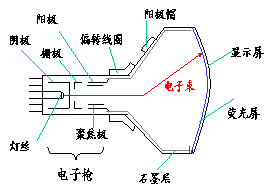Composition and operating principle of CRT cathode ray tube
The core component of the CRT display is a cathode ray tube, which is a funnel-shaped electric vacuum device, which is composed of a display screen, an electron gun, and a deflection control device, as shown in Figure 5.3.

Figure 5.3 Composition of cathode ray tube
The display screen is the main part of displaying information. It is composed of a glass screen and a thin layer of phosphor coated on its inner wall. This layer of phosphor can emit light spots of different colors and brightness under the impact of an electron beam. In order to display information on the display screen, there must be relevant parts for providing the electron beam and selecting the impact position of the electron beam on the screen;
The electron gun is a component used to generate electron beams, and is composed of a filament, a cathode level, a grid level, an anode level, and a focusing level. The working principle of the electron gun is as follows:
The filament generates heat after being energized, which causes the cathode to be heated, and the heated cathode will release a large number of electrons; the grid is used to control the number of electrons that these electrons enter the anode area through the grid and then hit the display screen. That is, the strength of the electron beam hitting the display screen; the positive level accelerates the electron beam to ensure that the electron beam has sufficient kinetic energy to improve the display brightness of the display screen; the focusing level is used to focus the electron beam, turning the original initial speed Electrons of unequal and different directions are focused into a very thin electron beam, so that a small bright spot can be formed on the display screen to ensure a high display clarity.
The deflection control device refers to the deflection coil sleeved on the tail of the cathode ray tube, which is used to control the trajectory of the electron beam along the horizontal and vertical directions, so as to accurately control the electron beam to hit any position on the display screen. This is the control function that must be implemented to display information on the full screen on the display screen.
For a color display, the displayed color should be made up of three basic colors of red, green and blue in a certain proportion. To this end, each pixel on the display screen must be composed of three small phosphor dots that can emit three colors of red, green and blue under the irradiation of an electron beam. They can be arranged into a regular triangle shape, and then They are equipped with an electron gun that independently controls the intensity of the electron beam, and ensures that the electron beams emitted by the three electron guns can accurately hit the corresponding small phosphor spots. To this end, the three electron guns should also be arranged in a regular triangle shape, and a shadow mask plate filled with small holes is installed near the fluorescent screen. The number of small holes and the number of groups of three-color phosphor dots (the number of pixels in monochrome) Consistent to ensure that the electron beams emitted by the three electron guns can pass through the same small holes and hit the corresponding small phosphor spots.
Aluminum circuit boards is a metal-based copper clad plate with good heat dissipation function. Generally, the single layer is composed of three-layer structure, which is a circuit layer (copper foil), an insulating layer and a metal base layer. Also used for high tech use is designed as double layers, the structure is circuit layer, insulation layer, aluminum base, insulation layer, circuit layer. A very small number of applications are multi-layer boards, which can be made of ordinary multi-layer boards combined with an insulating layer and an aluminum base.
Aluminum PCB characteristics
â— Surface Mount Technology (SMT);
â— Extremely efficient treatment of thermal diffusion in circuit design;
â— Reduce product operating temperature, increase product power density and reliability, and extend product life;
â— Reduce product size and reduce hardware and assembly costs;
â— Replace the fragile ceramic substrate for better mechanical durability.
Aluminum PCB use:
â— Audio equipment
Input, output amplifiers, balanced amplifiers, audio amplifiers, preamplifiers, power amplifiers, etc.
â— Power supply equipment
Switching regulator, DC/AC converter, SW regulator, etc.
â— Communication electronic equipment
High frequency amplifier, filtering appliance, reporting circuit, etc.
â— Office automation equipment
Motor drive, etc.
â— Automotive
Electronic regulator, ligniter, power controller, etc.
â— Computer
CPU board, floppy disk drive, power supply unit, etc.
â— Power module
Inverter, solid relay, rectifier bridge and so on.
â— LED lighting
With the promotion of energy-saving lamps, various energy-saving and beautiful LED lamps have been well received by the market, and aluminum PCB used for LED lamps have also begun to be applied on a large scale.
Aluminium Pcb,Aluminum Pcb Prototyping,Aluminium Pcb Board,Aluminium Circuit Boards
Chuangying Electronics Co.,Ltd , https://www.cwpcb.com
